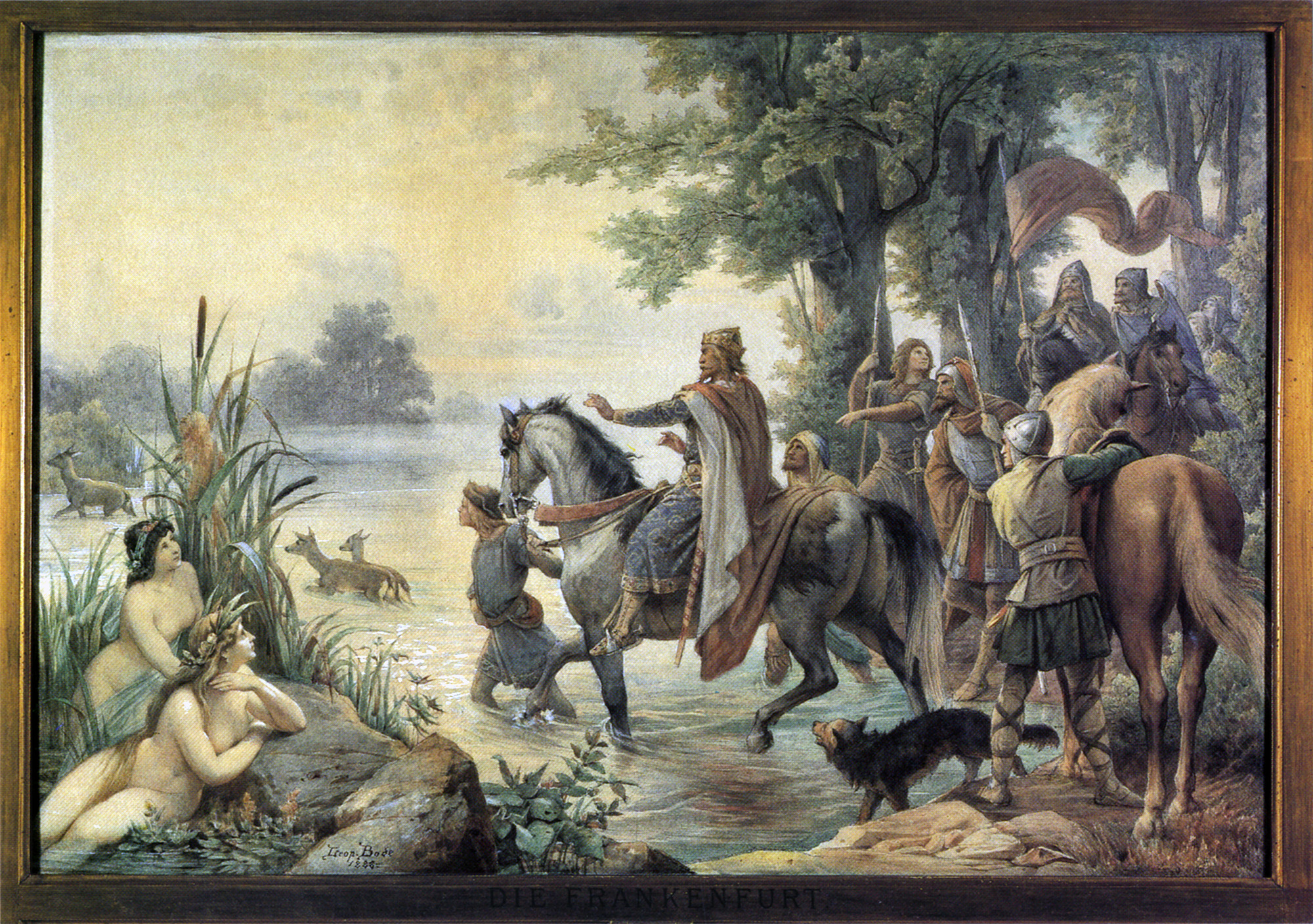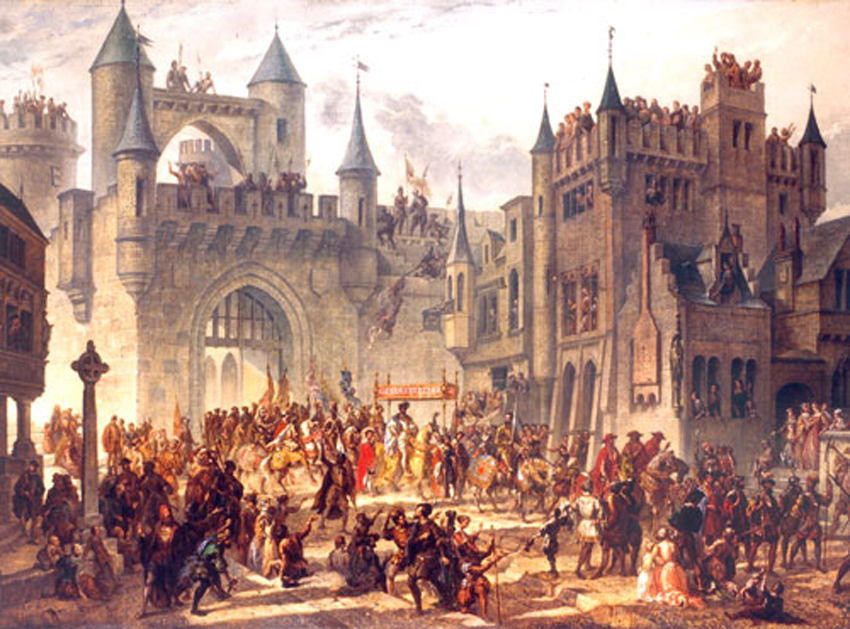|
Franz Von Sickingen
Franz von Sickingen (; 2 March 14817 May 1523) was a knight of the Holy Roman Empire who, with Ulrich von Hutten, led the so-called " Knights' War," and was one of the most notable figures of the early period of the Protestant Reformation. Sickingen is posthumously known as "the last knight" (''der letzte Ritter''), an epithet he shared with his contemporaries Chevalier de Bayard and Emperor Maximilian. Early life Franz von Sickingen was born on 2 March 1481 at Ebernburg Castle in the Palatinate of the Holy Roman Empire to Schweickhardt von Sickingen and his wife Margarethe Puller von der Hohenburg. Franz was married to Hedwig von Flersheim (d. 1515). Having fought for the emperor Maximilian I against Venice in 1508, he inherited large estates on the Rhine, and increased his wealth and reputation by numerous private feuds, in which he usually posed as the friend of the oppressed. In 1513, Sickingen took up the quarrel of Balthasar Schlör, a citizen who had been drive ... [...More Info...] [...Related Items...] OR: [Wikipedia] [Google] [Baidu] |
Worms, Germany
Worms (; ) is a city in Rhineland-Palatinate, Germany, situated on the Upper Rhine about south-southwest of Frankfurt, Frankfurt am Main. It had about 84,646 inhabitants . A pre-Roman foundation, Worms is one of the oldest cities in northern Europe. It was the capital of the Kingdom of the Burgundians in the early fifth century, hence is the scene of the medieval legends referring to this period, notably the first part of the ''Nibelungenlied''. Worms has been a Roman Catholic Prince-Bishopric of Worms, bishopric since at least 614, and was an important Count palatine, palatinate of Charlemagne. Worms Cathedral is one of the imperial cathedrals and among the finest examples of Romanesque architecture in Germany. Worms prospered in the High Middle Ages as an imperial free city. Among more than a hundred imperial Diet (assembly), diets held at Worms, the Diet of 1521 (commonly known as Diet of Worms, ''the'' Diet of Worms) ended with the Edict of Worms, in which Martin Luther wa ... [...More Info...] [...Related Items...] OR: [Wikipedia] [Google] [Baidu] |
Charleville-Mézières
Charleville-Mézières () is a commune of northern France and the prefecture of the Ardennes department, in the Grand Est region. Charleville-Mézières is located on the banks of the river Meuse. History Charleville and Mézières were originally separate communities on opposite banks of the Meuse, about from one another. Charleville was founded by Charles Gonzaga, the 8th duke of Mantua, in 1606. Its inhabitants were known as Carolopolitans (' or ''Carolopolitaines''). It was prosperous from the 17th century, although its fortifications were dismantled under Louis XIV in 1687 and it passed into French hands in 1708. It was plundered by the Prussians in 1815. France's royal armaments factory was formerly located there and gave its name to the Charleville musket, before being relocated and divided between Tulle and Châtellerault. In the 19th century, the city continued to produce arms through private firms, as well as nails, hardware, wine, spirits, coal, iron, and sl ... [...More Info...] [...Related Items...] OR: [Wikipedia] [Google] [Baidu] |
Picardy
Picardy (; Picard language, Picard and , , ) is a historical and cultural territory and a former regions of France, administrative region located in northern France. The first mentions of this province date back to the Middle Ages: it gained its first official recognition in the 13th century through the nation of Picardy at the University of Paris and entered French administration in the 14th century. Unlike regions such as Normandy, Brittany, or Champagne (province), Champagne, Picardy was never established as a duchy, county, or principality, and its boundaries fluctuated over the centuries due to the political instability in the area it covered. Since 1 January 2016, it has been part of the new region of Hauts-de-France. The first geographic description of Picardy appeared in the late central Middle Ages, including the bishoprics of Amiens, Beauvais, Arras, Tournai, and Thérouanne. In the late Middle Ages, it also encompassed Saint-Quentin, Douai, Abbeville, Béthune, Clermo ... [...More Info...] [...Related Items...] OR: [Wikipedia] [Google] [Baidu] |
Charles V, Holy Roman Emperor
Charles V (24 February 1500 – 21 September 1558) was Holy Roman Emperor and Archduke of Austria from 1519 to 1556, King of Spain (as Charles I) from 1516 to 1556, and Lord of the Netherlands as titular Duke of Burgundy (as Charles II) from 1506 to 1555. He was heir to and then head of the rising House of Habsburg. His dominions in Europe included the Holy Roman Empire, extending from Germany to northern Italy with rule over the Austrian hereditary lands and Burgundian Low Countries, and Spain with its possessions of the southern Italian kingdoms of Naples, Sicily and Sardinia. In the Americas, he oversaw the continuation of Spanish colonization and a short-lived German colonization. The personal union of the European and American territories he ruled was the first collection of realms labelled " the empire on which the sun never sets". Charles was born in Flanders to Habsburg Archduke Philip the Handsome, son of Maximilian I, Holy Roman Emperor and Mary of Burg ... [...More Info...] [...Related Items...] OR: [Wikipedia] [Google] [Baidu] |
Frankfurt
Frankfurt am Main () is the most populous city in the States of Germany, German state of Hesse. Its 773,068 inhabitants as of 2022 make it the List of cities in Germany by population, fifth-most populous city in Germany. Located in the foreland of the Taunus on its namesake Main (river), Main, it forms a continuous conurbation with Offenbach am Main; Frankfurt Rhein-Main Regional Authority, its urban area has a population of over 2.7 million. The city is the heart of the larger Rhine-Main metropolitan region, which has a population of more than 5.8 million and is Germany's Metropolitan regions in Germany, second-largest metropolitan region after the Rhine-Ruhr metropolitan region, Rhine-Ruhr region and the List of EU metropolitan regions by GDP#2021 ranking of top four German metropolitan regions, fourth largest metropolitan region by GDP in the European Union (EU). Frankfurt is one of the ''de facto'' four main capitals of the European Union (alongside Brussels, Luxembourg Cit ... [...More Info...] [...Related Items...] OR: [Wikipedia] [Google] [Baidu] |
Francis I Of France
Francis I (; ; 12 September 1494 – 31 March 1547) was King of France from 1515 until his death in 1547. He was the son of Charles, Count of Angoulême, and Louise of Savoy. He succeeded his first cousin once removed and father-in-law Louis XII, who died without a legitimate son. A prodigious patron of the arts, Francis promoted the emergent French Renaissance by attracting many Italian artists to work for him, including Leonardo da Vinci, who brought the ''Mona Lisa'', which Francis had acquired. Francis's reign saw important cultural changes with the growth of central power in France, the spread of humanism and Protestantism, and the beginning of French exploration of the New World. Jacques Cartier and others claimed lands in the Americas for France and paved the way for the expansion of the first French colonial empire. For his role in the development and promotion of the French language, Francis became known as (the 'Father and Restorer of Letters'). He was also known ... [...More Info...] [...Related Items...] OR: [Wikipedia] [Google] [Baidu] |
Ulrich, Duke Of Württemberg
Duke Ulrich of Württemberg (8 February 14876 November 1550) succeeded his kinsman Eberhard II as Duke of Württemberg in 1498. He was declared of age in 1503. His volatile personality made him infamous, being called the "Swabian Henry VIII" by historians. Early life Duke Ulrich was born 8 February 1487 and his mother died in his birth. His father, Henry, Count of Württemberg, was mentally deranged, likely as a result of his three-year imprisonment by Duke Charles the Bold of Burgundy, was banished to Hohenurach Castle in the County of Urach, and his only guardian died when he was nine years of age. Ulrich served the German king, Maximilian I, in the War of the Succession of Landshut in 1504, receiving some additions to Württemberg as a reward; he accompanied Maximilian on his unfinished journey to Rome in 1508; and he marched with the imperial army into France in 1513. Meanwhile, in Württemberg Ulrich had become very unpopular. His extravagance had led to a large acc ... [...More Info...] [...Related Items...] OR: [Wikipedia] [Google] [Baidu] |
Swabian League
The Swabian League () was a military alliance of Imperial State, imperial estates – Free imperial city, imperial cities, prelates, principalities and knights – principally in the territory of the early Middle Ages, medieval stem duchy of Swabia established in 1488. New institutions created through imperial reform removed the need for the league, whilst the religious revolution of the Protestant Reformation divided its members, leading to the Swabian League being disbanded in 1534. History The Swabian League was established in 1488 at the behest of Emperor Frederick III, Holy Roman Emperor, Frederick III and supported as well by Berthold von Henneberg, Bertold, Elector of Mainz, whose conciliar rather than monarchic view of the ''Reich'' often put him at odds with Frederick's successor Maximilian I, Holy Roman Emperor, Maximilian. The Swabian League cooperated towards the keeping of the imperial peace and at least in the beginning curbing the expansionist History of Bavaria, ... [...More Info...] [...Related Items...] OR: [Wikipedia] [Google] [Baidu] |
Oligarchy
Oligarchy (; ) is a form of government in which power rests with a small number of people. Members of this group, called oligarchs, generally hold usually hard, but sometimes soft power through nobility, fame, wealth, or education; or through corporate, religious, political, or military control. Throughout history, power structures considered to be oligarchies have often been viewed as coercive, relying on public obedience or oppression to exist. Aristotle pioneered the use of the term as meaning rule by the rich, contrasting it with aristocracy, arguing that oligarchy was a corruption of aristocracy. Types Minority rule The consolidation of power by a dominant minority, whether religious or ethnic, can be considered a form of oligarchy. Examples include South Africa during apartheid, Liberia under Americo-Liberians, the Sultanate of Zanzibar, and Rhodesia. In these cases, oligarchic rule was often tied to the legacy of colonialism. In the early 20th ... [...More Info...] [...Related Items...] OR: [Wikipedia] [Google] [Baidu] |
Metz
Metz ( , , , then ) is a city in northeast France located at the confluence of the Moselle (river), Moselle and the Seille (Moselle), Seille rivers. Metz is the Prefectures in France, prefecture of the Moselle (department), Moselle Departments of France, department and the seat of the parliament of the Grand Est Regions of France, region. Located near the Tri-border area, tripoint along the junction of France, Germany and Luxembourg,Says J.M. (2010) La Moselle, une rivière européenne. Eds. Serpenoise. the city forms a central part of the European Greater Region and the SaarLorLux euroregion. Metz has a rich 3,000-year history,Bour R. (2007) Histoire de Metz, nouvelle édition. Eds. Serpenoise. having variously been a Celts, Celtic ''oppidum'', an important Gallo-Roman city,Vigneron B. (1986) Metz antique: Divodurum Mediomatricorum. Eds. Maisonneuve. the Merovingian capital of Austrasia,Huguenin A. (2011) Histoire du royaume mérovingien d'Austrasie. Eds. des Paraiges. p ... [...More Info...] [...Related Items...] OR: [Wikipedia] [Google] [Baidu] |
Rhenish Guilder
The Rhenish ''gulden'' or Rhenish ''guilder'' (; ) was a gold, standard currency coin of the Rhineland in the 14th and 15th centuries. They weighed between 3.4 and 3.8 grams (). History The Rhenish gold ''gulden'' was created when the Prince-elector, electors of Electorate of Cologne, Cologne, Electorate of Trier, Trier and Archbishopric of Mainz, Mainz were rewarded for their support in the election of Charles IV (HRR), Charles IV with a right to mint gold coins (), a right derived from the Golden Bull of Charles IV, Golden Bull. Trier was given the privilege on 25 November 1346, Cologne on 26 November 1346 and Mainz on 22 January 1354. The Rhenish ''gulden'' or ''florin'' began in 1354 as a copy of the Florentine ''florin'' (weight th a Cologne Mark of gold, 23 karats fine, or 3.43 g fine gold). However, by the early 15th century it has lost nearly one quarter of its gold content. In 1419 it was th a Cologne Mark of gold, 19 karats fine; hence 2.76 g fine gold. As a result ... [...More Info...] [...Related Items...] OR: [Wikipedia] [Google] [Baidu] |






